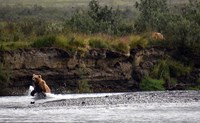"To him [the grizzly bear] almost everything is food except granite." -John Muir
NPS/Matt Cameron 

NPS/Kent Miller Surviving the long Arctic winter—where food is scarce and wind chills can dip to -95°F—requires a strategy to conserve energy; for brown bears this means denning. After spending much of the very short Arctic summer fattening up, brown bears excavate dens for use during the long Arctic winter. In Gates of the Arctic, winter can last up to eight months, the location and provisioning of the den site is important to a bear’s survival. Relying on experience, brown bears choose den sites that maximize energy conservation.Though they rarely reuse the same den in Gates of the Arctic, brown bears typically return to the same area each winter to den. Using their long, powerful claws, brown bears excavate dens on steep slopes (31° on average) to optimize drainage and stability. Brown bears typically select areas with deep snowpack for insulation, and they further insulate their dens by lining the floors and entrances with vegetative material such as grass and moss. Biologists believe bears in Gates of the Arctic build new dens each year because most dens collapse during the intervening summer as the ground thaws. While denning, a bear's heart and breathing rates slow (a state called torpor that is not considered full hibernation as observed in Arctic ground squirrels), it doesn’t eat, and sows (adult females) give birth and nurse cubs without fully waking. 
NPS/Kent Miller
Maintaining healthy brown bear populations in Alaska’s parks is an important mission for NPS. Reliably estimating the size of the low-density population of brown bears across the 8.5 million acres of Gates of the Arctic, in addition to the 8.8 million acres of the neighboring Noatak National Preserve, Kobuk Valley National Park, and Cape Krusenstern National Monument, is not an easy task, yet it is critical for setting harvest regulations. Hunting is an important traditional aspect of life in Alaska, and brown bears are harvested by subsistence hunters throughout Gates of the Arctic and sport hunters in the Itkillik and Kobuk Preserves. Biologists and pilots conduct population surveys from small fixed-wing aircraft across these large areas. Photographs of individual bears recorded on one flight are used to identify bears and distinguish them from bears seen on a second flight in the same area. These surveys help us track population trends and manage the effects of human activities that directly affect brown bear survival. Population size is not the only measure of the health of a population; genetic characteristics of individuals can help scientists understand how resilient the population may be to environmental changes and disease. Brown bears in Gates of the Arctic have lower levels of gene transcription (gene expression that directs how cells in the body function) than bears in Katmai and Lake Clark. This is a sign that brown bears in this area are more physiologically challenged than bears from southern coastal populations and may be more susceptible to stressors like disease. This kind of microscopic information can alert us to environmental stressors that affect individual bears, their populations, and even their habitat. 
NPS/Matt Cameron Ninety-five percent of brown bears in the United States live in Alaska, and Gates of the Arctic is an important refuge for brown bears adapted to life in the Arctic. The Arctic is changing rapidly, and the potential impacts to brown bear populations are not fully understood. We will continue to monitor, study, and conserve brown bears in Gates of the Arctic to ensure that these magnificent animals remain a vital part of the Park and Preserve’s ecosystem for generations to come. Related ContentShowing results 1-10 of 13
|
Last updated: November 15, 2022










